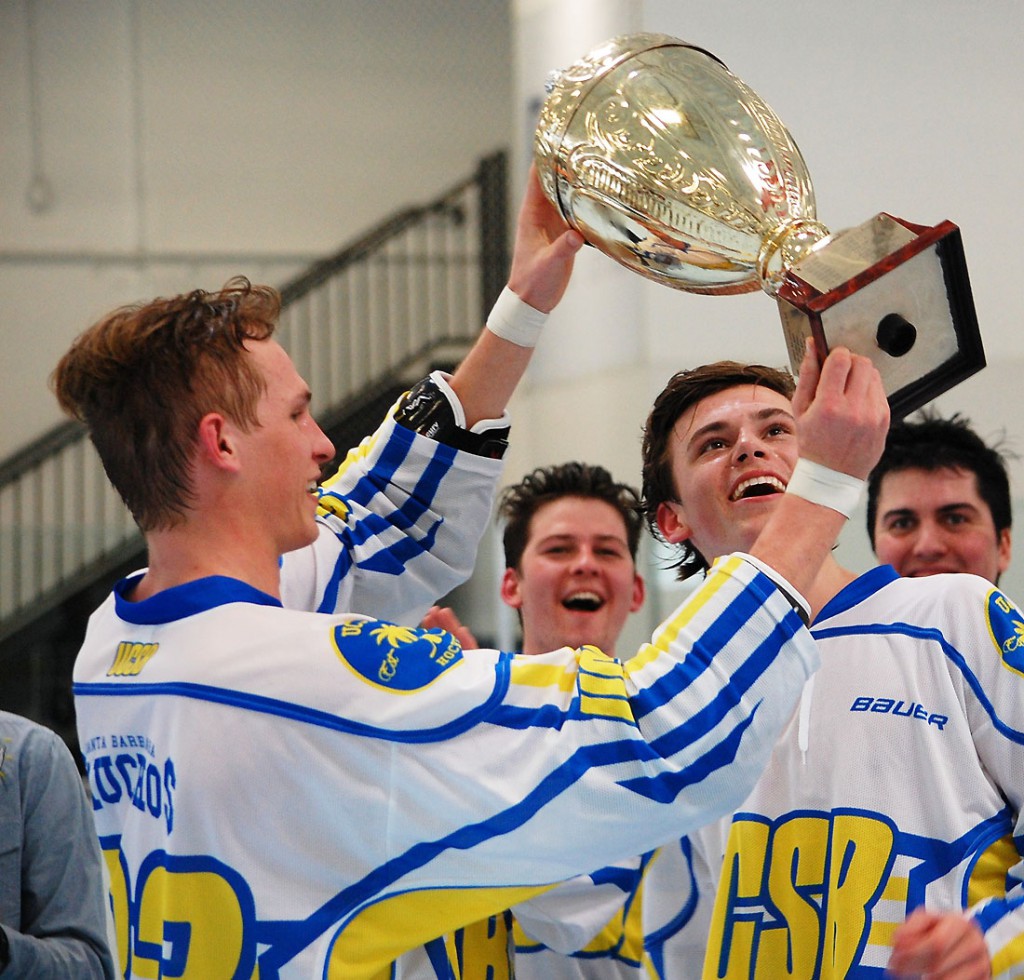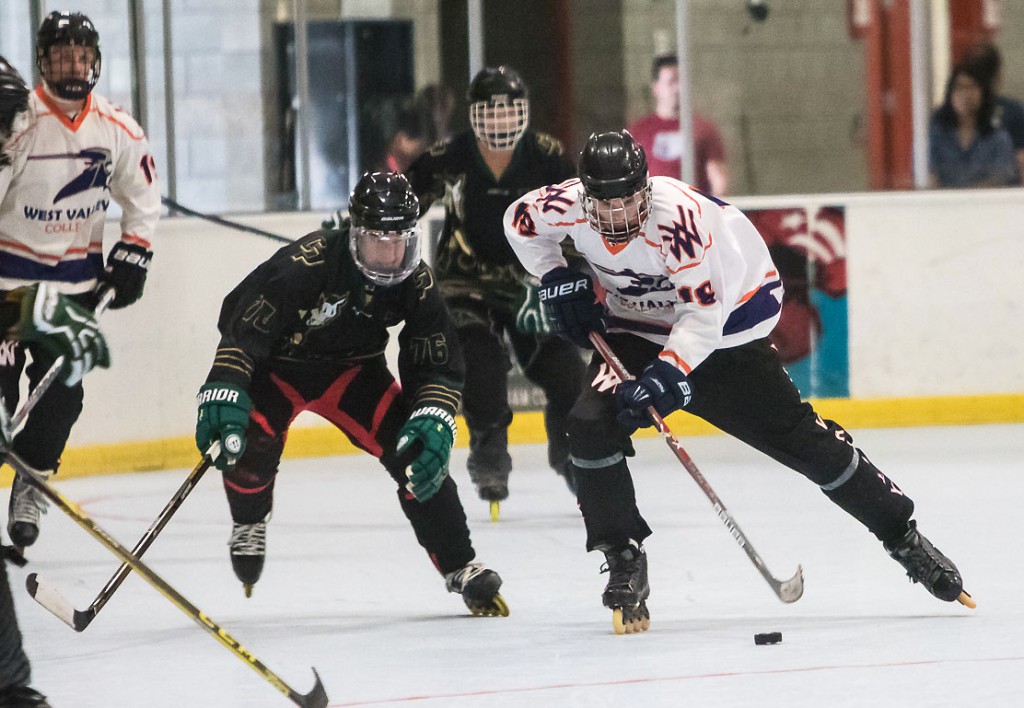WCRHL teams head to Florida for collegiate inline nationals

Nine teams from the Western Collegiate Roller Hockey League (WCRHL) will be out to accomplish the same goal at April’s National Collegiate Roller Hockey Championship tournament in Ft. Myers, Fla.
That goal: to win the championship title in their respective divisions.
Teams traveling from the West Coast for the April 5-9 event include UC Santa Barbara, Arizona State University and Cal Poly San Luis Obispo in Division I; Chico State, University of Arizona, CSU Fullerton and Northern Arizona University in Division II; CSU Fullerton in Division III; and West Valley College in the Junior College Division.
It appears to be a very potent bunch.
UC Santa Barbara, this year’s WCRHL Division I regional champion, carries an overall 20-2-0-1 record (regular season and playoffs combined) into the Florida nationals event while, in Division II, Chico State is 16-2-0-1 on the season and Fullerton is 15-4. Arizona (13-6-0-2) enters the fray as two-time WCRHL regional champions.
Meanwhile, West Valley finished runner-up at last year’s nationals and, with a core group of players ready to make the jump to four-year universities next year, the Vikings are highly motivated to win this year’s national championship.
When asked what it takes to be successful at nationals, WCRHL director and National Collegiate Roller Hockey Association (NCRHA) executive director Brennan Edwards was quick to formulate an answer: discipline, smart play and roster depth.
“There are talented teams in each division, but it will come down to how often you are on the power play and penalty kill, as the top teams can score at will when on the power play,” Edwards explained. “Teams with shorter benches will find it more difficult as the top few teams have large benches and will wear you out by the third period.”
Format
Teams will play round-robin matches during preliminary play, then advance to single-elimination bracket play based on preliminary-round seeding.
“All teams get seeded into the brackets regardless of their round-robin finish,” Edwards said.
Edwards said teams are seeded into the elimination brackets based on their round-robin results. However, he said that in each division the pools lay into the brackets slightly differently.
“Basically in Division I and Division II, the top two pools are seeds 1, 3, 5, 7 in Pool A and 2, 4, 6, 8 in Pool B, and then in all other pools a mix of teams 9 through the end. In Division III, the pools are A: 1, 2, 3, 4; B: 5, 6, 7, 8; C: 9, 10, 11, 12
A total of 21 teams are competing in five pools in Division I. Pool play starts April 5 and concludes with the national championship game on April 8.
UC Santa Barbara is included in Pool B alongside Bethel University, Lindenwood University and Michigan State University.
Michigan State finished regular season play16-0 and tacked on three more wins to capture the Midwest Collegiate Roller Hockey League (MCRHL) regional championship. Bethel, which won a national championship in 2012, finished runner-up to Lindenwood in this year’s Great Plains Collegiate Inline Hockey League (CPCIHL) regional championship game.
Arizona State University is competing Florida Gulf Coast University, University of Massachusetts and University of Rhode Island in Pool C.
Florida Gulf Coast finished 7-1 in regular season play in the Southeastern Collegiate Roller Hockey League (SECRHL) while UMass and Rhode Island finished 13-5 and 11-6-0-1, respectively, in the Eastern Collegiate Roller Hockey Association (ECRHA) regular season standings.
Cal Poly San Luis Obispo is included in Pool D alongside Miami (Ohio) University, Rowan University and West Chester University.
Miami (Ohio) finished third in the Midwest Collegiate Roller Hockey League (MCRHL) regular season standings while West Chester (14-3-0-1) and Rowan (9-8-0-1) both posted winning regular season records in the ECRHA.
There are 20 teams competing in five pools in Division II. Pool play starts April 5 and concludes with the national championship game on April 9.
Chico State joins the University of Akron, East Carolina University and Stony Brook University in Pool A.
Akron finished regular season play 13-1-0-1 but went 0-2 at the ensuing Midwest regional tournament with losses to DePaul University (regional champion) and Ohio State (regional runner-up). East Carolina defeated Virginia Tech to capture this year’s Southeastern regional championship while Stony Brook topped the ECRHA regular season standings with a 16-2 record.
Two-time defending WCRHL regional champion University of Arizona is set to battle the University of Arkansas, Kansas State University and the University of Tennessee-Knoxville in Pool B. The Wildcats will face off pool play against a trio of defending regional champions.
Arkansas (12-3 in the regular season) won the Southwest Collegiate Hockey League (SCHL) regional championship while Kansas State (14-2 in the regular season) captured the Great Plains Collegiate Inline Hockey League (GPCIHL) regional title. Tennessee (8-3-0-1 in the regular season) defeated East Carolina, 3-2, to win the Southeastern regional championship.
CSU Fullerton will compete in Pool C alongside the University of Denver, Illinois State University and Yeshiva University.
Denver won this year’s Rocky Mountain Collegiate Roller Hockey League (RMCRHL) regional championship. Yeshiva finished regular season play 15-2-0-1 while Illinois State fell to Kansas State in the GPCIHL regional championship game.
Northern Arizona University joins Louisiana Tech, Ohio State University and State University of New York at Oswego in Pool E. The Lumberjacks will face off pool play against a trio of teams that finished runner-up in their respective regional championships.
Louisiana Tech finished runner-up (to Arkansas) in the Southwest regional while Ohio State University finished runner-up in the Midwest regional and Oswego finished runner-up to Northeastern University in the ECRHA regional.
There are 12 teams in three pools in Division III. Pool play starts April 7 and concludes with the division championship on April 9.
CSU Fullerton is included in Pool C alongside State University of New York at Cortland, Florida Gulf Coast University and Hofstra University.
Florida Gulf Coast defeated rival Florida State to win the Southeastern regional title while Cortland and Hofstra finished fourth and fifth, respectively, in the regular season ECRHA standings.
Lindenwood University, braced by nine Californians on its roster, will compete in Pool A against Farmingdale State College, Grand Valley State University and Michigan State University.
Lindenwood defeated Lindenwood Black, 13-1, to finish as this season’s GPCIHL regional champion while Farmingdale State won the ECRHA regional championship. Grand Valley State posted a 13-1-0-1 regular season record in the Midwest region standings, followed by Michigan State at 9-7.
Three teams will be competing for this year’s Junior College Division championship: West Valley College from the WCRHL and Missouri’s St. Charles Community College and St. Louis Community College, both from the Great Plains region.
St. Charles defeated West Valley for last year’s division title. Division play starts April 7 and concludes April 9.
Outlook
Defending national champions include Neumann University (Division I), UMass (Division II), Lindenwood University (Division III) and St. Charles Community College (JC Division).
Longtime NCRHA power Lindenwood should be considered a contender to capture both the Division I and Division III titles this year. Edwards sees Farmingdale State, Neumann University and Lindenwood panning out as the top three teams in Division I.
Farmingdale State defeated Neumann, 5-4, to capture this year’s ECRHA regional championship.
Lindenwood has advanced to three of the last four Division I national championship games and has won 10 Division I titles overall. The Lions have held a stranglehold on the Division III title by winning 12 of the 13 national championships contested in the division.
Lindenwood’s Division III roster includes Golden State products Spenser Marquiss (San Jose), Jon Gauthier (San Diego), Chris Visico (San Jose), Daniel Higa (Saratoga), Thompson Teague (Escondido), Jason Novak (Chico), Mark Birchall (Escondido), Jake Escarcega (Escondido) and goaltender Charles Robinson (Chico).
Gauthier led the Lions in regular season scoring with 38 points, followed by Escarcega with 37 points and Marquiss with 36 points. Robinson posted a 10-3 regular season record with three shutouts, a 1.92 GAA and .883 save percentage.
Other teams to keep an eye on in Division III include Farmingdale and Michigan State. Edwards calls the division “tough.”
Michigan State edged Grand Valley State, 2-0, in the Midwest region championship game while Farmington State blitzed Rowan University, 7-3, to win the ECRHA region title.
St. Charles has won the last eight national JC Division championships and 15 overall in the division.
As for the prospects of the WCRHL teams?
While UC Santa Barbara’s Division I team may be in the midst of what senior Kyle Mooney calls a “magical season,” the Gauchos are not invincible despite their imposing record.
UC Santa Barbara lost its first pool-round game at the WCRHL regionals to fourth-seeded Long Beach State, 4-3 in overtime, but quickly regrouped with four victories to claim the regional title.
The Gauchos scored 98 goals in 16 games during regular season play. Kevin Mooney (27), Kyle Mooney (18) and Kyle Clements (14) accounted for 59 or 60 percent of those goals. Kevin Mooney led the division with 53 points, followed by older brother Kyle with 51 points and Clements (third in the division) with 32 points.
Kevin Mooney topped the Gauchos with seven game-winning goals while Clements topped the team with six power play goals. Kyle Mooney led the division with 33 assists.
Goaltender Colin Menz ranked third in the division with a 3.92 goals-against average and .830 save percentage but led the division with a 13-3 record.
The Gauchos hope the magic continues at nationals.
“Our squad is excited to play in the national championships in Florida and feel that we can make a good run at the national title,” Kyle Mooney explained. “Collectively, we felt that our best game of the season was in the regional championship final, and feel that we are peaking at the perfect time of the season.
“We know that the competition at nationals is going to be on another level and our key to success will definitely be lockdown defense, as offense has not been an issue for us this season. Our goalie, Colin Menz, has been playing his best hockey we have seen and, as long as our team can support him in that, we think that we can compete with the best teams in the division.
“We do not have the deepest bench, so it will be important for every player on our roster to contribute. Being in pool B gives us an opportunity to play some good teams in the round-robin games and finish as a high seed going in the playoffs. We definitely would like to get some revenge on Lindenwood as they were our first loss of the season in a nail-biter 3- 2 game.
“I feel that Newman will be the toughest team to beat, and we would also love to meet University of Missouri-St. Louis in the playoffs as they knocked us out of nationals last year.”
Cal Poly SLO, which lost by a 7-1 score to UC Santa Barbara in the WCRHL Division I regional championship game, is not without its own potent mix of talent. Daniel Kumata led the Mustangs during the regular season with 16 goals and 26 points, followed by Alex Waddel (17 goals, 24 points). Joe Blakewell finished third in team scoring with 18 points but led the team with 14 assists.
Waddel paced the team with five game-winning goals and four power play goals.
Goaltender Mitchell Myjak led the division with a 3.37 GAA and .851 save percentage.
“Cal Poly needs to play as a team if they want to be successful at nationals,” explained Kumata, who serves as club president. “Too much this season we have had individual efforts. We need to play disciplined man-on- man hockey, stay out of the penalty box and control the puck on offense. If we do these few things, we will go far in the tournament.”
The Mustangs (15-8 overall on the season) finished 3-2 at the WCRHL regional tournament, with both losses to UC Santa Barbara.
ASU’s Division I team finished regular season play with three players (Ryan Cotton, Wes Fry and Jayme Haveman) who scored 20 or more points and two more players (Travis Ringeman and Stetson Dirks) who each tacked on 15 points.
Cotton led the team with 22 points (11 goals, 11 assists) and four game-winning goals, while Fry (11 goals, nine assists) and Haveman (10 goals, 10 assists) each racked up 20 points.
Ringeman (11 goals, four assists) and Dircks (seven goals, eight assists) each collected 15 points. Trevor Weinstock (five goals, eight assists) also collected 13 points.
Goaltender Braxton Schulz turned in a solid season with a 3.56 GAA with a division-leading two shutouts and division-leading .857 save percentage.
The Sun Devils came within a 1-0 loss to Cal Poly SLO in the semifinals of advancing to this year’s regional championship game against UC Santa Barbara.
“Our goal all year was to get better throughout the season, and grow as a unit,” ASU coach Nick Boyarsky explained. “I believe we have done that. Both leading up to regionals and at practices since, the team has been working on key system tweaks and special teams improvement.
“We played a very tight regionals with Poly (1-0 loss in the semifinals) and UCSB (4-3 loss in pool play), and I think we’re prepared to do the same at nationals. The goal here, like any other weekend, is to face it game by game and reevaluate and adjust as we do so.
“Senior Braxton Schulz, our goalie, has had a fantastic year, and is playing the strongest of his four years in the program. We’ll be relying on him to continue that play. Forwards Jacob Romo and Wes Fry will also be relied on to give us full strength scoring as well as being key parts of our special teams.”
ASU finished runner-up to Lindenwood University at the 2010 nationals
Chico State finished on top of the regular season Division II standings with a 14-1-0-1 record and allowed the fewest goals (34) in the division. The Wildcats faced off the regional tournament with a pair of pool wins but lost, 5-3, to Northern Arizona University in the semifinals.
“Regionals didn’t turn out the way we wanted it to,” Chico State club president Zac Claunch admitted. “We had a few poor games and didn’t get the result we wanted. For nationals I want to make it as far as we can. It would be awesome if we could get into the top four and finish at the top of the country. That would be awesome.
“We, as a team, are just looking forward to nationals in Florida, having a good time and trying to be as competitive as possible and getting as far as we can.”
Claunch (27 goals, 19 assists) and Cole Euell (28 goals, 18 assists) tied for both the team and division regular season point-scoring lead. Claunch tallied six game-winning goals while Euell collected six power play goals.
Goaltender Michael Wood registered a 14-2 regular season record with four shutouts, a 2.05 GAA and .892 save percentage — all tops in the division.
CSU Fullerton finished second in the regular season Division II standings with a 13-3 record and finished as the highest scoring team in the division with 130 goals. The Titans won their opening two pool games, then lost 7-5 to eventual champion U-of-A in the semifinals.
“Going into nationals our club has set some high expectations,” noted club president Ron Best. “After a lackluster showing at end of the regular season as well as regionals, the team has been working hard in practice to come out and solidify ourselves as a powerhouse team in Division II. We have been looking to sharpen up our defensive zone coverage as well as giving our special teams a boost heading into the final tournament of the year.
“After getting to play in my first national championship tournament last year, I have a new look on the event. At nationals, any team can beat each other, especially in Division II. Pool play will also be extremely important as some lost leads in pool play last year were what cost us more ideal seeding for a long playoff run.
“We are hoping to come in and show our group what this team is truly about before we hit the bracket play. Our whole team is very excited and confident in ourselves leading into this year’s tournament. We are hoping to prove that we can accomplish what we fell short of last year, which was to win a national title.”
Fullerton did win a national championship in 2014, so a precedent has already been set.
The Titans had 11 players score at least 10 points during the season, so the offense is well rounded. Regular season team leaders include Anthony Squirek (24 goals, 37 points), Ricky May (16 goals, 32 points), Troy Yano (18 goals, 29 points), Kyle Alexander (9 goals, 21 points), Griffin Cortes (6 goals, 19 points) and Nick Balaban (10 goals, 19 points).
Eight players tallied game-winning goals during the regular season. Squirek notched five game-winning goals. He and May also led the team with four power play goals.
Best is 12-3 between the pipes with a 3.07 GAA, one shutout and .835 save percentage.
The University of Arizona finished 11-3-0-2 in third place in the regular season Division II standings but rallied, as was the case last year, to battle back to win the regional championship title in overtime.
Team leaders for the Wildcats during the regular season included Jesse Rooney (21 goals, 44 points), Jacob Toro (19 goals, 34 points) and Taylor Knight (15 goals, 33 points). Six players chipped in with game-winning goals this season. Toro led the team with three game-winners.
Goaltender Brett Bushnell appeared in all 16 regular season games, posting an 11-5-0 record with one shutout, a 3.37 GAA and .834 save percentage.
At regionals, Arizona lost its opening two pool games (4-3 in overtime to Northern Arizona University and 6-3 to Fullerton) but finished the tournament with three consecutive wins, including wins over both Fullerton (7-5 in the semifinals) and NAU (5-4 in overtime in the finals).
“Going into nationals our biggest concern is our special teams,” Bushnell explained. “That has been our weakest link in our game and it has hurt us in a few games during the regular season. We also need to watch our discipline during the games. During our first game against CSU Fullerton at the regional championships, we were in the box eight times, which is exactly half the game. A lot of teams we will be playing in Ft. Myers will be able to capitalize on that, so we need to be aware of that.
“Playing in a national championship tournament is very exciting. You are playing against only the top teams in your league, all of which have the same goal as you, to make it to the championship game. The atmosphere of it all too is amazing. The league does a really nice job with making you feel like you’re in the big time by getting these arenas for us to play in, as well as having official ID badges for all players and coaches.”
Northern Arizona University posted a fifth-place regular season showing with its 6-9-0-1 record but rocked the division with a runner-up finish at regionals. The first-year team – led by veterans Trevor Riffey and Austin Cannon – is looking to make some noise at the NCRHA nationals.
Riffey, who had prior playing experience with Long Beach State, led NAU in regular season scoring with 30 goals and 41 points. He racked up seven power play goals in 15 games.
Cannon (formerly with the University of Arizona) finished fourth in team scoring with 12 goals and 16 points. He led the team with 37 penalty minutes and notched two game-winning goals.
Riffey had more than double the points of the next high scorer on the team — Jordy Maugeri (6 goals, 17 points). Sam Fleming finished third on the team with 16 points to match Cannon. Camden Taylor (15 points) matched Cannon with two game-winning goals.
Anders Hultgren played in all 16 regular season games with a 6-10 record, 5.65 GAA and .803 save percentage.
The Lumberjacks compiled a 3-2 record at regionals, with both losses by one goal in overtime.
Riffey scored 23 of his team’s 26 goals at regionals. More of the same could enable NAU to leave an imprint in the tournament.
“We just need to play how we did in regionals if we want to make a run at natty’s,” Riffey explained “Giving all we have and taking one game at a time will help us in pool play and hopefully into playoffs as well.
“It’s a little different because we only play one game a day or maybe two, so we have plenty of time to rest in between games unlike some other tournaments throughout the year where we have played six games in two days. This should help us because we don’t really practice at all because we only have a concrete rink; sometimes we get tired after a couple games. This schedule should turn out good for us.
“None of our guys except for Austin and I have ever played in a tournament like this, so it will be fun to be able to compete against some good teams from across the country. We really have nothing to lose. This is our first year in the NCRHA and we already made nationals, so that’s big step in itself but we are hoping to make a big run nonetheless.
“Playing in a national championship tournament like this is a blast. I had the opportunity to play in two natty’s with Long Beach State and it was just a great atmosphere playing and watching teams from all over the place. It’s an intense tournament as every team wants to show that their school is the best, so we have to come to play when we get to Florida.”
Fullerton finished in fourth place in the regular season WCRHL Division III standings with an 8-7-0-1 record in a highly competitive division. The Titans went 0-3 at the regional championship tournament with losses to the three teams that finished ahead of them in the regular season standings.
The appearance at nationals should be a growing experience for the team.
Top scorers during the regular season included Blake Kaprelyan (17 goals, 27 points) and Matthew Greene (13 goals, 18 points). Greene led the team with four power play goals and 41 penalty minutes in 14 games.
Jason Silva played the bulk of minutes in the net, posting an 8-5 record, 4.31 GAA and .821 save percentage.
West Valley has been sitting idle since its last regular season game – a 3-2 overtime win over Long Beach State on Feb. 19 – as the Vikings advanced directly to nationals with a bye at the regional level.
West Valley compiled a 9-4 regular season record (11-6 overall including exhibition games) while playing primarily Division I and Division II teams this season. The Vikings finished 7-0 against Division II teams to earn a prominent feather in their cap and were 4-6 against Division I teams.
Matt Swanson led West Valley with 15 goals and 25 points in 12 regular season games. Thomas Hartshorn finished second in team scoring with eight goals and 22 points. Swanson led the team with three game-winning goals and three power play goals.
Jarrit Baker and Danny Salazar finished in a tie for third in team scoring with seven goals and 13 points each. Nathan Olocki finished fifth in team scoring with 11 points. Olocki matched Swanson with three game-winners.
Jack Robinson posted a 6-3 record with a 3.37 GAA, one shutout and an .849 save percentage while Nicholas Defayette finished 2-1 with a 2.33 GAA, one shutout and .873 save percentage between the pipes.
There are a lot of returning players from last year’s national championship runner-up team who want to finish what they couldn’t last season.
“Our team is well-rounded with everyone contributing offensively,” Swanson explained. “In Florida, we need to continue to work as a team and stay focused for every game.”
One of the top benefits to playing in the JC Division at nationals is the exposure, as many Division I coaches scout the JC games for recruiting purposes.
Late scratches
Eleven WCRHL teams initially received bids to the nationals following the conclusion of the regional championships. However, four declined due to either high travel costs or late season injuries.
Long Beach State University declined its bid in Division I while ASU, UC Santa Barbara and West Valley College all declined bids in Division III. Fullerton advanced as an alternate in Division III.
ASU’s Boyarsky noted this is the first time since the 2009-10 season that the Sun Devils haven’t fielded a Division III team at the NCRHA nationals.
“Although we were given a bid, the nine-man roster we had started the second semester with was plagued with injuries to the point where, after regionals ended, we just didn’t have the manpower to compete on a national level,” Boyarsky explained. “Our seniors, led by club president Kyle Friedman, battled hard all season; it’s very unfortunate we couldn’t end their ASU stint with a solid run at a national championship.”
For tournament updates, visit www.wchrl.com or www.ncrha.org.
Photos/WCRHL, Ed Salazar (West Valley College)
— Phillip Brents











